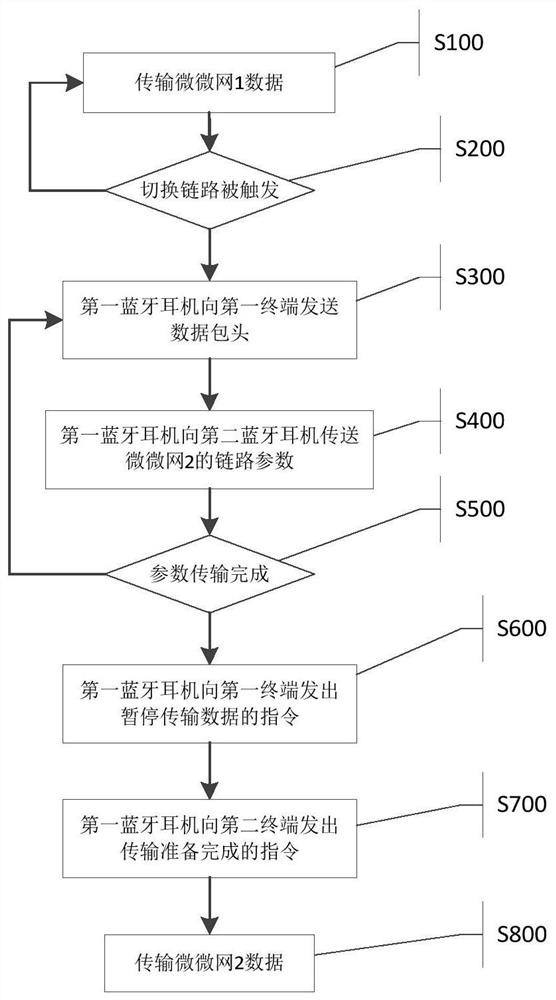Bluetooth multi-terminal link switching method, Bluetooth audio equipment and Bluetooth system
A Bluetooth audio and link switching technology, applied in transmission systems, digital transmission systems, and multiple use of transmission paths, can solve problems such as inability to transmit data, lack of information exchange functions, and asynchronous playback of dual headphones, avoiding The effect of data loss and synchronous reception of data
- Summary
- Abstract
- Description
- Claims
- Application Information
AI Technical Summary
Problems solved by technology
Method used
Image
Examples
Embodiment 1
[0050] This embodiment is a Bluetooth multi-terminal link switching method, wherein piconet 1, piconet 2, and piconet 3 all use an asynchronous data link (ACL) to transmit audio data packets via the AVDTP protocol.
[0051] Such as figure 2 Shown in is the flowchart of this embodiment.
[0052] S100: Transmitting audio data based on the piconet 1, the first terminal sends an audio data packet to the first Bluetooth earphone through the ACL via the AVDTP protocol (Audio / Video Distribution Transport Protocol audio and video distribution transmission protocol), and the second Bluetooth headset According to the first link parameter of the piconet 1, the earphone synchronously receives the audio data packet through the listening link. In the piconet 1, the first terminal acts as a master device (Master), and the first Bluetooth headset acts as a slave device (Slave);
[0053] S200: When the user issues a link switching command to the first Bluetooth headset through an external i...
Embodiment 2
[0080] This embodiment is a Bluetooth multi-terminal link switching method, wherein piconet 1 and piconet 3 both use an asynchronous data link (ACL), and piconet 2 uses a synchronous data link (ESCO).
[0081] This embodiment and figure 2 The embodiment 1 process shown in is basically the same, the difference is:
[0082] S200: The first Bluetooth headset polls and finds that the second terminal in the piconet 2 has sent Alerting signaling to the first Bluetooth headset through the asynchronous data link (ACL) via the HFP protocol, requesting to establish a synchronous data link (ESCO), because The priority of Alerting signaling is higher than the operation of receiving audio data packets, and the link switching instruction is triggered.
[0083] Such as Figure 4 Shown is the time slot allocation diagram of this embodiment.
[0084] time slice S 1 It is a time segment of piconet 1 starting with the master-slave time slot and ending with the master-slave time slot, and th...
Embodiment 3
[0100] This embodiment is a Bluetooth multi-terminal link switching method, wherein piconet 3 adopts asynchronous data link (ACL), and piconet 1 and piconet 2 both adopt synchronous data link (eSCO).
[0101] This embodiment and figure 2 The embodiment 1 process shown in is basically the same, the difference is:
[0102] S200: The first Bluetooth headset polls and finds that the second terminal in the piconet 2 has sent Alerting signaling to the first Bluetooth headset through the asynchronous data link (ACL) via the HFP protocol, requesting to establish a synchronous data link (eSCO). A Bluetooth headset can prompt the user whether to switch, such as playing a piece of prompt audio, etc. If the user manually issues a link switching command, the first Bluetooth headset will execute the link after receiving the last real-time voice data packet before triggering the link switching command. switch operation.
[0103] Such as Figure 5 Shown is the time slot allocation diagram...
PUM
 Login to View More
Login to View More Abstract
Description
Claims
Application Information
 Login to View More
Login to View More - R&D
- Intellectual Property
- Life Sciences
- Materials
- Tech Scout
- Unparalleled Data Quality
- Higher Quality Content
- 60% Fewer Hallucinations
Browse by: Latest US Patents, China's latest patents, Technical Efficacy Thesaurus, Application Domain, Technology Topic, Popular Technical Reports.
© 2025 PatSnap. All rights reserved.Legal|Privacy policy|Modern Slavery Act Transparency Statement|Sitemap|About US| Contact US: help@patsnap.com



